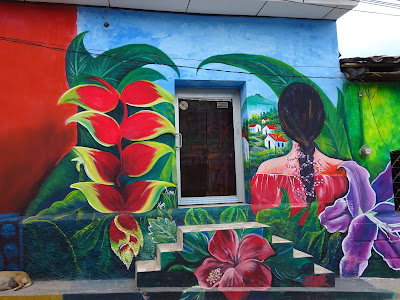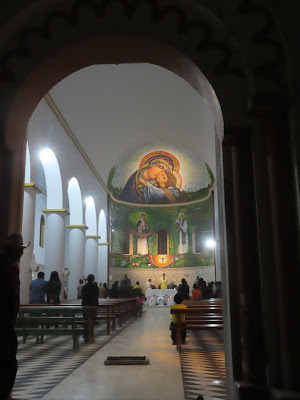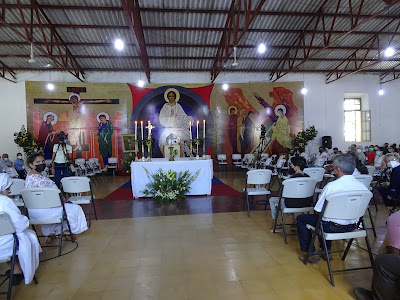When we look at ourselves, what allows a man, with an already established personality and ego-identity, to step forward to be ordained a deacon or priest, when all along he has been a broken human being, fraught with faults and failings? Has another story been writing his life? In a way, yes. It is nothing less than the narrative grace of the story of Jesus Christ. which is the transforming power of the Holy Spirit at work deep inside each person who professes faith in Jesus Christ and desires to serve him in the mission of the church. That narrative grace of the 3Holy Spirit, who so powerfully transformed the apostles, seeks to powerfully transform, through holy orders and the Eucharist, all ordained servant-leaders in the church. (p. 34)Put aside for the moment the important questions of the role of women in the church. You may want to rephrase the quote to reflect your calling.
Tuesday, May 31, 2022
Turning seventy five
Monday, May 30, 2022
Toward a spirituality of service - in the form a critical book review
… While the common priesthood of the faithful is exercised by the unfolding of baptismal grace … the ministerial priesthood is at the service of the common priesthood. It is directed at the unfolding of the baptismal grace of all Christians.The second is that the author subordinates his spirituality of service for the laity to a diaconal spirituality.
“Step 4: The apostles, having received this gift-of-self from Christ in the forms of the priesthood and diaconate, now gift themselves, in the forms of that same priesthood and diaconate, to their successors, the bishops.
Step 5: The bishops, having received this gift-of-self from the apostles in the forms of the priesthood and diaconate, now gift themselves to priests and deacons through the conferral of Holy Orders.
Step 6: The priests and deacons, having received this gift-of-self from the bishop in the forms of the priesthood and diaconate, now reveal in a distinctive and complementary manner the whole Christ (Christus totus). As a result, they gift themselves to the laity through evangelizing and the sacraments.
Step 7: The laity, having received this gift-of-self from priests and deacons, now gift themselves in the living out of their vocations for the salvation of the world. (pp. 58-59).In this reading, those who are ordained appear as those who give the gift-of-self, whereas it would be better to say that God gives the gift-of-self through the Church, The Body of Christ, through the ministry of the bishop, priest, deacon.
…ordination is not only the hierarchical transmission of powers but also the consecration of the action by which the Church orders her charity and builds herself into a body in realization of the ministry that is concomitant with the state of being a Christian. To have a vocation to the priesthood, to prepare and present oneself for ordination, and eventually to receive consecration from the bishop is to be called to Christian service in a more concentrated, more specific way, to be qualified to become a leader in this service and publicly to accept its character, having first accepted it in one’s heart and striven to be worthy of it.There is one other concern I have that I cannot at this time articulate very well. While reading both books, I find myself concerned that some of the author’s expressions might lead to a dualism. In Encountering Christ the Servant, the author, while discussing the work of John Collins, writes on page 88)
The deacon’s service is first and foremost to God rather than to the people; only in God and with His grace can he truly serve the people.Is there really such a distance between serving God and serving the people?
Saturday, May 21, 2022
Murals beautifying Dulce Nombre 2
 |
| The plane that was taken through Dulce Nombre from the Concepción Copán airport. |
 |
| The bus of Tato who was recently killed in his bus, while parked in Santa Rosa. |
 More photos can be seen at this Flickr album here.
More photos can be seen at this Flickr album here.Murals beautifying Dulce Nombre 1
“The world will be saved by beauty.”
Fyodor Dostoevsky |
| Alejandro Carbajal at the inauguration of the festival of murals |
I have an album of all the photos I am taking of the murals on flickr. You can access it here.
Sunday, May 15, 2022
Philip the Deacon and Saint Nunzio Sulprizio
Like a sheep he was led to the slaughter, and as a lamb before its shearer is silent, so he opened not his mouth. In his humiliation justice was denied him.
Tuesday, May 03, 2022
When? A deacon's examen
 |
| The four seminarians in the first year. |
“We are called to discover Christ in them, to lend them our voice in their causes, but also to be their friends, to listen to them, to understand them and to welcome the mysterious wisdom that God wants to communicate to us through them.”We can and should listen to them when they come to us – whether they come asking for material help or come to participate in the church.
 |
| Corn and beans drying in a house in the village where I went on Good Friday. |
Sunday, May 01, 2022
Holy Week 2022
A late update.
In our parish we begin the celebrations of Holy Week with a parish Stations of the Cross in Dulce Nombre on the Friday before Palm Sunday. We walk through the streets of Dulce Nombre, stopping at fourteen stations, followed by Mass in the main church to celebrate La Virgen Dolorosa, Our Mother of Sorrows.
Migration, mostly to the US, has devastated some parts of the parish. People pay coyotes, often an exaggerated sum of money, to get them to the US. This leaves some villages with few men. In many places, this also wreaks havoc on families.
Violence continues to devastate the parish. There have been cases this year of murders. In addition, there is the hidden violence of domestic violence and abuse (sexual and psychological). The abuse of alcohol and the use of drugs continues to plague some communities.
Alcoholism has long been a problem. More recently, selling and use of drugs has become a problem. We remember these and other concerns, recalling how Jesus shares our sufferings and our concerns.
Palm Sunday was cold and rainy. I had a cold but still went to the Procession and Mass in Dulce Nombre. I preached, but I didn’t walk in the procession. Instead, I rode in the car with the sound system since I felt a cold coming on.
Tuesday, I went to a rural village to visit the sick and for a Celebration of the Word with Communion.
Thursday was busy. First of all there was the Chrism Mass in Santa Rosa de Copán. It was good to be there – and also to see a few friends.
After the Mass (and coffee with a friend, Padre Pato), I went to a Celebration of the Word with Communion and Washing of the Feet in Concepción, at 3 pm.
At 5pm I was in La Colonia San José Obrero for another Celebration of the Word with Communion and Washing of the Feet. They had arranged twelve chairs on one side of the church for the twelve men whose feet were to be washed. I didn’t say anything beforehand, though in the Holy Week planning sessions I’d emphasized that they should include men and women, young and old. But, after I washed the feet of the twelve men, I asked if there were any women whose feet I could wash. Four women agreed.
At 7 pm, I was in the main church for the Mass of the Lord’s Supper. As our pastor, Padre German, washed the feet of twelve persons, I found myself accompanying him and drying the feet with a towel. We hadn’t arranged that, but it just seemed natural for this deacon.
Good Friday, I went to two remote villages. In the morning I went to El Higon, a small hamlet whose delegate died a few years ago. They had planned to go to a nearby village but were glad to be able to do the Stations in their small village. The people had arranged the stations on the road with small bouquets of flowers. It simple, but a moving sign of the people’s faith and devotion.
In the afternoon, I went to Mar Azul for the Service of the Passion and the Veneration of the Cross.
Holy Saturday is a day of rest – remembering and awaiting the resurrection. For many years, this has been a day to prepare for the Easter Vigil – by baking bread and cinnamon rolls.
The Vigil began at about 6 pm and entered about midnight. After the blessing of the fire and the Paschal Candle, we walked to the new auditorium for the Celebration of the Word, the Baptism of 29 catechumens, and the Celebration of the Eucharist. We heard all the readings and the responses to the readings were sung.
The Baptisms were held in the entrance to the auditorium. One young woman, an aspirant to the community of religious in Dulce Nombre, whispered to me, “What joy!” You could see it in the faces of many of the baptized as the paster doused them with the baptismal water.
I got home and couldn’t sleep until about 1 am.
I got up a little later than usual, but I arrived in time for a Celebration of the Word with Communion in a distant village.
After the Celebration I planned on going to La Entrada to have Eatser lunch with the Dubuque Franciscan sisters, bearing cinnamon rolls and fresh-baked whole wheat bread.
The people told me that there was a back way to get to the main highway to La Entrada. I had traveled it once with the pastor, but I managed to get lost. I knew I was lost when I saw the road plunge to a ravine with fifteen-inch rocks. I turned around and started back when I came across a few people who told me how to get to the highway. They even offered to send their son as a guide. I declined the offer, but when I got to one point, I felt myself lost again. Fortunately, there were some people in a nearby stream who showed me the way out. It was an adventure.
I arrived in time for a great visit with the three sisters and a great meal. I got home and was glad to be able to relax.
Monday morning I had two pre-marriage interviews. I did take some time off to stay at home (and wash clothes and clean the house.) Such was my Holy Week.
On the first Sunday after Easter I ended up taking four seminarians from the diocese to the seminary in Tegucigalpa – six hours away. After early morning Mass in Concepción, where the pastor had me preach, we headed out. The four are in the first year of seminary formation, which is set aside to help prepare the candidates for their studies. The public school system here is so deficient that a year is set aside to help the new seminarians learn study skills and more. Some don’t need it as much as others, but it just underlines the poor educational system here.
At the seminary, I had two chances to talk with the thirty or so first year seminarians about the permanent diaconate. There are only six deacons in the whole country. Four were ordained for the archdiocese of Tegucigalpa (and at least three of them are academics). I was ordained for the diocese of Santa Rosa de Copán. Another deacon, José Peñate, came with his family as a missionary and has been in the Tegucigalpa area for about seven years (working in a very poor area.)
While I was preparing to speak to the seminarians, I began to realize that for me the accompaniment of the poor is a critical aspect of being a deacon. I really need to make an examen of life every week, asking myself when was the last time I was in the home of a poor person. When it’s been a while, I need to reform my life and get out and visit.
I stayed in Tegucigalpa until Tuesday. I even had a chance to meet Deacon José before I left.
The trip home was longer than the trip to Tegucigalpa. I stopped in Siguatepeque to purchase a few things – and had a double dip ice cream cone from the Mennonite Store. Just before Intibucá I stopped at a roadside stand where I bought strawberries as well as a bunch of asparagus.
I had never encountered asparagus in Honduras until I passed the same stand about four years ago. I usually stop at this stand to buy strawberries and other fruits and vegetables, but finding asparagus there was a real surprise. The woman was there with her three kids – one a few months old. The oldest (about 11) helped with my order of strawberries. I ended up talking with the woman and two of her kids. She was proud that the two older boys were in school and that the first grader loved school and was learning very easily. She was proud that he was so smart. As I drove, I asked myself, “why did I take time to talk with the mother and her kids?” My first thought was because I want to give them a sense of being important and worth listening to. But then I told myself, “You do it because you love them.”
I also stopped at a café near Yaramanguila where we had stopped on the way to Teguc. The owner had purchased some asparagus for me, and I stopped to get it. She gave me five bunches – as a gift.
I ended up sharing two bunches with US Protestant missionaries in Santa Rosa whom I know. (I tried calling the sisters in Gracias, but no one answered.) I love asparagus but couldn’t eat that much. I had received a gift and so I too had to share. I got home after 5 pm, but I didn’t collapse until I had prepared and eaten rice and asparagus.
That’s a summary of the last few weeks.
In all this I thank God – and the people who are so good to me.




































